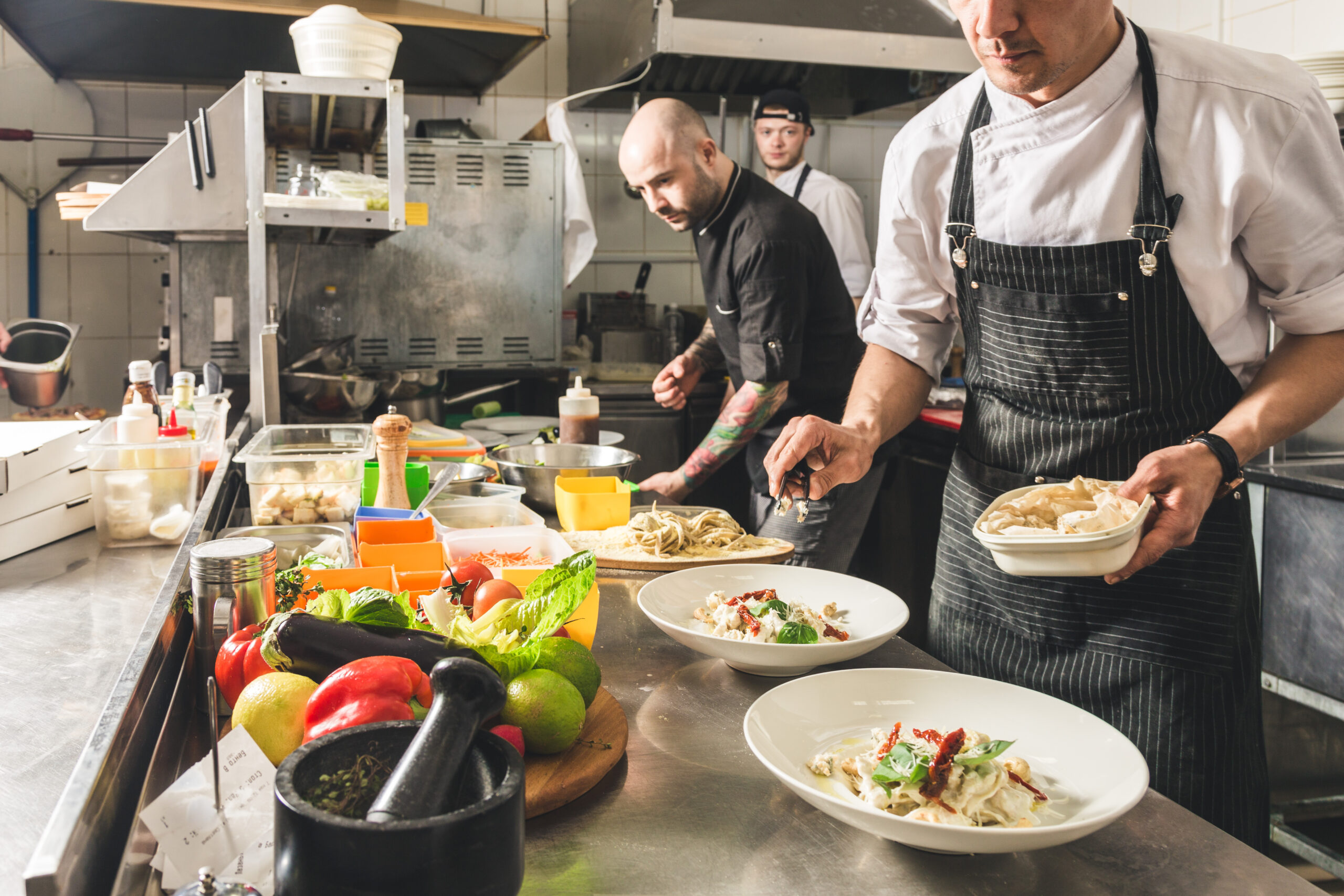Certificate III in Commercial Cookery
BACK TO COURSESCertificate III in Commercial Cookery
ABOUT THE COURSE
This qualification reflects the role of cooks who use a wide range of well-developed cookery skills and sound knowledge of kitchen operations to prepare food and menu items. Using discretion and judgement, they work with some independence and under limited supervision using plans, policies and procedures to guide work activities.
Completion of this qualification contributes to recognition as a trade cook.
This qualification provides a pathway to work as a cook in organisations such as restaurants, hotels, clubs, pubs, cafes, and coffee shops. The skills in this qualification must be applied in accordance with Commonwealth and State or Territory legislation, Australian standards and industry codes of practice.
No occupational licensing, certification or specific legislative requirements apply to this qualification at the time of publication.
Recognised by Australian Qualifications Framework and Nationally Recognised Training
Details
Course Code:
SIT30821
CRICOS Course Code:
114253J
Work Placement:
240 hours
Location:
Melbourne Campus
Delivery Mode:
Face to Face and Kitchen Based
Study Load:
20 per week + 5 hours self study
Fees:
Please see the Fees and Charges page or contact the campus directly!
Intake:
Duration:
Up to 52 Weeks*
(This qualification will be delivered as full-time study over the course of 104 weeks including 8 weeks of breaks/holidays. Duration may vary based on mode of delivery and/or RPL and CT)

Course Entry Requirements
There is no pre-requisites or specific entry requirement for this qualification. This course is available to all international students as along as they can provide the evidence that:
- The Student must be 18 years or older at the time of course commencement,
- The Student has successfully completed the Australian Year 12 (or equivalent) and,
- The Student have an IELTS score of at least 6.0 or PTE Academic score of 50 (or equivalent) OR Successful completion of ELICOS (English for Academic Purposes (EAP) or General English) at Advanced level.
- Note: Citizens of certain countries are exempted from the English proficiency requirement, please contact AIA for further details or visit the DOHA Website.

Additional Entry Requirements:
- Students commencing this course will be required to complete the Language, Literacy and Numeracy (LLN) assessment on the orientation day. This will assist AIA to identify the student needs for any additional support during their study.
- Practical’s for students must complete their practical in AIA kitchen facilities or as advised otherwise. Where students are required to come to campus or kitchen, and use the available facilities and resources, they should be advised of the date and time of the delivery and assessment, where they are required to visit the campus and/or kitchen and complete their assessment requirements in the compliant way and in accordance with Standard 1.8 of SRTO 2015.
- AIA will make all possible efforts and aim to secure workplace arrangements for all enrolled students.
- Students must have access to working PC or laptop with a configuration suitable to meet study requirements – please seek your trainer/assessor assistance in this regard.
- Students must have basic digital literacy such as, the ability to communicate and access the information through digital technologies, social media, search engines, emails and/or basic use of Microsoft Office products and have access to the working internet.
- If the student educational qualification does not meet the AIA’s admission requirements, other factors may be considered at the discretion of AIA. For more information, please see the AIA’s Admissions Policy available in the Forms & Policies page.
- Reference Textbooks:
Math for the Professional Kitchen, The Culinary Institute of America, Laura Dreesen, Michael Nothnagel, Susan Wysocki
The Professional Chef, 9th Edition, The Culinary Institute of America
The Book of Yields, 8th edition, Francis T. Lynch

CAREER PATHWAYS
Where will the Certificate III in Commercial Cookery take me?
If you complete this course successfully, you may work as a qualified chef in a variety of establishments.
Reception Centre Chef
Hospital Chef
Restaurant Chef
Bistro Chef
Nursing Home Chef
Motel/Hotel Chef
STUDY PATHWAYS
The further study pathways available to students who undertake this qualification include:
Once you’ve successfully completed the Certificate III in Commercial Cookery SIT30821 you can move into:
SIT40521 Certificate IV in Kitchen Management or/
Any other Diploma level qualification with the SIT Tourism, Travel and Hospitality Training Package.
Course Structure
A total of 25 Units (20 Core and 5 electives) must be completed and deemed competent to achieve the qualification SIT30821 Certificate III in Commercial Cookery.
Participants who achieve competency in any unit/s will receive a Statement of Attainment (provided USI is verified) for that unit/s without completing all 25 units in the qualification. Students completing all the required units of competency will attain full qualification.
| Code | Title | Core/Elective |
|---|---|---|
| SITHCCC023* | Use food preparation equipment | Core |
| SITHCCC027* | Prepare dishes using basic methods of cookery | Core |
| SITHCCC028* | Prepare appetisers and salads | Core |
| SITHCCC029* | Prepare stocks, sauces and soups | Core |
| SITHCCC030* | Prepare vegetable, fruit, eggs and farinaceous dishes | Core |
| SITHCCC031* | Prepare vegetarian and vegan dishes | Core |
| SITHCCC035* | Prepare poultry dishes | Core |
| SITHCCC036* | Prepare meat dishes | Core |
| SITHCCC037* | Prepare seafood dishes | Core |
| SITHCCC041* | Produce cakes, pastries and breads | Core |
| SITHCCC042* | Prepare food to meet special dietary requirements | Core |
| SITHCCC043* | Work effectively as a cook | Core |
| SITHKOP009* | Clean kitchen premises and equipment | Core |
| SITHKOP010 | Plan and cost recipes | Core |
| SITHPAT016* | Produce desserts | Core |
| SITXFSA005 | Use hygienic practices for food safety | Core |
| SITXFSA006 | Participate in safe food handling practices | Core |
| SITXHRM007 | Coach others in job skills | Core |
| SITXINV006* | Receive, store and maintain stock | Core |
| SITXWHS005 | Participate in safe work practices | Core |
| SITHCCC040* | Prepare and serve cheese | Elective |
| SITHCCC038* | Produce and serve food for buffets | Elective |
| SITHCCC025* | Prepare and present sandwiches | Elective |
| SITXCCS014 | Provide service to customers | Elective |
| SITXWHS006 | Identify hazards, assess and control safety risks | Elective |

Assessments Methodology, CT and RPL
Assessment Methodology
Assessment methods used for this qualification are varied and will provide a range of ways for individuals to demonstrate that they have met the required outcomes. Assessment methods may include:
- Written questions, projects and presentations
- Report writing and role plays/observations
- Kitchen based demonstration or work placement
At the beginning of each unit, your trainer and assessor will outline the assessment tasks that must be completed.
Credit Transfer (CT)
If a certificate or statement of results is produced and verified a credit transfer process will be initiated by AIA in relation to the units as per training plan. Credit transfer is an process that provides students with agreed and consistent credit outcomes for components of a qualification based on identified equivalence in content and learning outcomes between matched qualifications (Source AQF)
Recognition of Prior Learning (RPL/RCC)
Upon enrollment of all learning programs, AIA code of practice of practice states that all candidates for assessment will be offered RPL. This is reiterated in the student handbook and acknowledged in writing RPL is an assessment process that assesses an individual’s non-formal and informal learning to determine the extent to which that individual has achieved the required learning outcomes, competency outcomes, or standards for entry to and/or partial or total completion of a qualification.
“Recognition of prior learning is an assessment process that involves assessment of an individual’s relevant prior learning (including formal, informal and non-formal learning) to determine the credit outcomes of an individual application for credit” (Source AQF)
FEES AND CHARGES
At AIA, we are committed to providing transparent information regarding our fees and charges to ensure that students have a clear understanding of their financial commitments. Our fees are structured to cover tuition, administration, and any additional services or materials required for your chosen course.
To access the comprehensive Fees and Charges document outlining the costs associated with our courses, please click the button below;


Ready to launch your career with AIA
ENROL NOW
